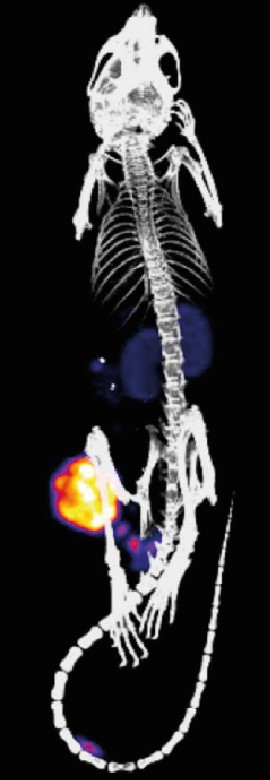New EU project designed to link diagnosis and treatment of diseases over the long term

Enhanced contrast will significantly improve the accuracy of cancer diagnosis. Ill./©: Click It Consortium
An international team from four EU countries plans to use an innovative concept to improve the use of companion diagnostics in disease and develop new approaches to therapy in the long term. The idea is to combine the use of nanomedicines and short half-life radionuclides for imaging purposes in the living organism.
First the nanomedicines, in the form of synthetic nanoparticles or antibodies, are introduced in the body where they actively or passively accumulate in certain organisms or cells. The second stage involves the delivery of a radioactive substance.
Where the substance encounters the nanoparticles, a rapid chemical reaction occurs and the two bind together, while the remainder of the substance is eliminated from the body. With the help of an imaging technique, it is now possible to precisely pinpoint where the nanoparticles are located, to what extent they have accumulated at the target site, and what effect they are having on the disease pathology. The EU is funding the project to the tune of EUR 6 million over the next five years.
Participating are physicians and clinicians from Copenhagen, chemists at TU Wien, and Johannes Gutenberg University Mainz (JGU), together with commercial partners from Austria and the Netherlands. The project was launched with the clear ambition of transferring the technology into clinical practice.
The research consortium aims at improving companion diagnostics and, at the same time, reducing exposure of patients to radioactivity to an absolute minimum. Companion diagnostics are tools in the form of medical devices that are used to assess medications in advance and can help determine which patients are likely to benefit from a treatment. For example, it is already possible to treat HER2-positive breast cancer using antibody therapy with relatively high therapeutic success rates.
However, only about 20 percent of all breast tumors are HER2-positive and the treatment is very expensive. It is thus advisable to first establish whether a patient is HER2-positive before initiating the therapy. Companion diagnostics can thus be used to determine if an individual patient is suitable for a specific form of therapy and would benefit from it or whether an alternative form of treatment should be preferred. In addition, the outcome of the therapy can be subsequently visualized. It is thus possible that the project may also contribute towards the future development of medicines that are more effective, more rapid, and less expensive.
“The system we are proposing would allow us to do far more than simply determine exactly where the nanoparticles are in the body,” explained polymer chemist Dr. Matthias Barz of the Institute of Organic Chemistry at Mainz University, who is involved in the project. “There is the imaging factor that will allow us to see where our nanoparticles with their specific function are located in the body. And, eventually, it should at some point be possible to use our approach in radiotherapy – making it truly unique.”
The two cooperation partners in Mainz, Dr. Matthias Barz and Professor Rudolf Zentel, are contributing their expertise in the production of microparticles of nanoparticles with specific functions. The European Union is making EUR 300,000 available over the next three years to fund their project.
Further information:
Dr. Matthias Barz
Institute of Organic Chemistry
Johannes Gutenberg University Mainz (JGU)
55099 Mainz, GERMANY
phone: +49 6131 39-26256
fax: +49 6131 39-24778
e-mail: barz@uni-mainz.de
http://www.ak-zentel.chemie.uni-mainz.de/1012.php
http://www.ak-zentel.chemie.uni-mainz.de/eng/index.php
http://www.uni-mainz.de/presse/19912_ENG_HTML.php – press release ;
http://www.ak-zentel.chemie.uni-mainz.de/eng/index.php – Zentel Group at the Institute of Organic Chemistry at Johannes Gutenberg University Mainz
Media Contact
All latest news from the category: Life Sciences and Chemistry
Articles and reports from the Life Sciences and chemistry area deal with applied and basic research into modern biology, chemistry and human medicine.
Valuable information can be found on a range of life sciences fields including bacteriology, biochemistry, bionics, bioinformatics, biophysics, biotechnology, genetics, geobotany, human biology, marine biology, microbiology, molecular biology, cellular biology, zoology, bioinorganic chemistry, microchemistry and environmental chemistry.
Newest articles

Why getting in touch with our ‘gerbil brain’ could help machines listen better
Macquarie University researchers have debunked a 75-year-old theory about how humans determine where sounds are coming from, and it could unlock the secret to creating a next generation of more…

Attosecond core-level spectroscopy reveals real-time molecular dynamics
Chemical reactions are complex mechanisms. Many different dynamical processes are involved, affecting both the electrons and the nucleus of the present atoms. Very often the strongly coupled electron and nuclear…

Free-forming organelles help plants adapt to climate change
Scientists uncover how plants “see” shades of light, temperature. Plants’ ability to sense light and temperature, and their ability to adapt to climate change, hinges on free-forming structures in their…





















